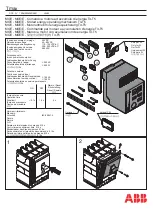
20
Instruction Book
IB182917EN September 2018 www.eaton.com
DHP-VR
+
VR-Series
+
Replacement Circuit Breaker
4.7 MISCELLANEOUS ITEMS
4.7.1 GROUNDING CONTACT
The grounding contact is an assembly of spring loaded fingers which
ground the circuit breaker frame (static ground) by engaging the
switchgear grounding bus when the circuit breaker is racked into the
circuit breaker compartment. The ground contact is located at the
rear of the circuit breaker near the floor and visible from the back
of the circuit breaker when out of the circuit breaker compartment.
(Figure 3.3.b)
4.7.2 MOC AND TOC OPERATIONS
A mechanism attached to the right side of the DHP-VR
+
circuit
breaker engages a channel of the pantograph that is linked to the
Mechanism Operated Cell Switch (MOC) located in the circuit
breaker compartment. This mechanism permits the contacts of
the MOC Switch to be correlated with the circuit breaker’s contact
position.
m
NOTICE
ALL TYPE DHP-VR
+
CIRCUIT BREAKERS UTILIZE THE DHP-VR
+
SURE
CLOSE
MECHANISM TO CONTROL MOC VELOCITY AND CLOSELY MIMIC
THE DYNAMICS AND VELOCITIES OF OLDER CIRCUIT BREAKERS. IT IS
IMPERATIVE THAT THIS MECHANISM BE ADJUSTED TO MATCH THE
NUMBER OF MOC SWITCHES (FROM 0 TO 3) MOUNTED IN THE CIRCUIT
BREAKER COMPARTMENT. ALWAYS CONFIRM THE MECHANISM IS
PROPERLY ADJUSTED BEFORE ANY ATTEMPT IS MADE TO INSERT THE
CIRCUIT BREAKER INTO THE CIRCUIT BREAKER COMPARTMENT.
IN ADDITION, THE MOC PANTOGRAPH MUST BE CHECKED BEFORE ANY
ATTEMPT IS MADE TO INSERT THE CIRCUIT BREAKER INTO THE CIRCUIT
BREAKER COMPARTMENT. DETAILED PROCEDURES FOR EACH TEST ARE
OUTLINED IN THE INSPECTION AND INSTALLATION SECTION OF THIS
MANUAL.
The circuit breaker compartment mounted Truck Operated Cell
Switch (TOC) is operated by movement of the circuit breaker truck
into or out of the ‘Connect’ position.
4.7.3 OPERATIONS COUNTER
All DHP-VR
+
circuit breakers are equipped with a mechanical
operations counter (Figure Set 3.3). As the circuit breaker opens,
the linkage connected to the pole shaft lever advances the counter
reading by one.
4.7.4 RACKING DEVICE
The purpose of the racking device is to move the circuit breaker
between the ‘Test’ and ‘Connect’ positions. The racking mechanism
is located in the circuit breaker truck on the DHP-VR
+
. The racking
nut is fastened securely to the guide tube and is loosely retained in
a housing fastened to the extreme rear of the circuit breaker chassis
(Figure Set 3.3).
The operation consists of engaging the rotatable racking nut on the
circuit breaker with the racking screw mounted on the rear wall of
the circuit breaker compartment. By traversing the racking nut along
the racking screw, the circuit breaker is moved between positions
within the circuit breaker compartment.
The guide tube is slotted lengthwise for a distance about equal to
the travel distance of the circuit breaker. The racking shaft has two
hardened pins that slide in the guide tube slot. Thus, as the racking
shaft is rotated, the guide tube and nut also rotate.
As the circuit breaker is racked in by clockwise rotation of the
racking handle, the pins on the racking shaft move toward the end
of the guide tube slot. As the rear pin comes out of the slot, the
racking shaft turns freely and the circuit breaker moves no further.
The end of the guide tube is shaped like a steep-pitch one-turn
screw thread so that when the racking shaft is rotated counter-
clockwise, the rear pin will catch and enter the slot and rotate the
guide tube and nut, withdrawing the circuit breaker. At the end of
the travel, the nut disengages from the screw and spins free.






































